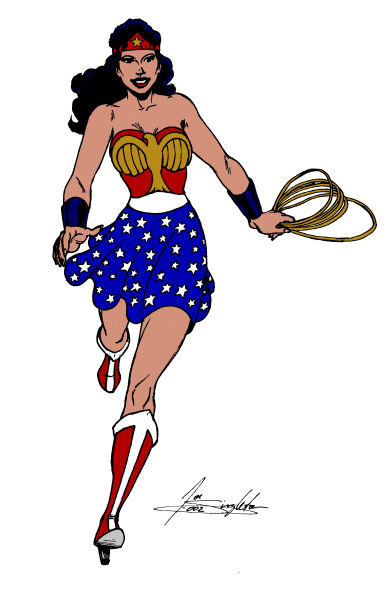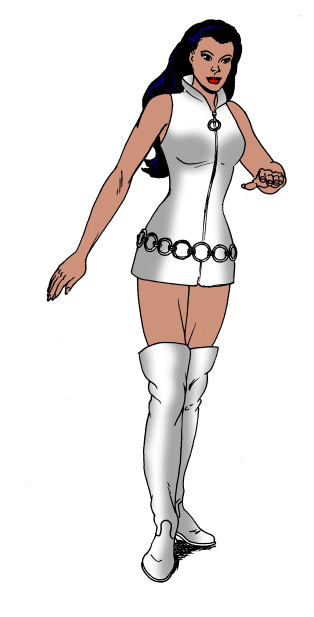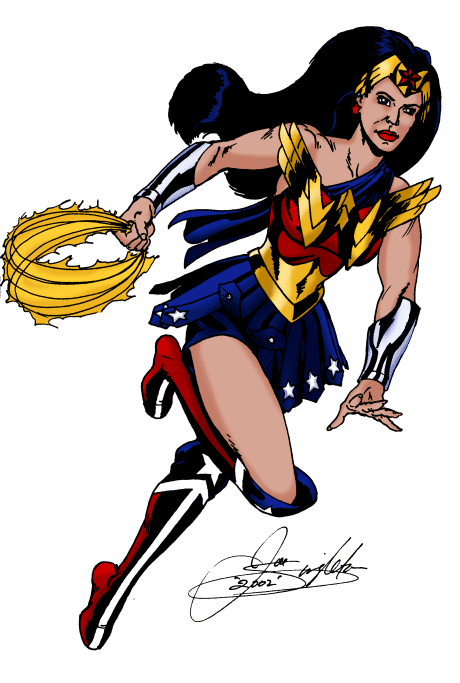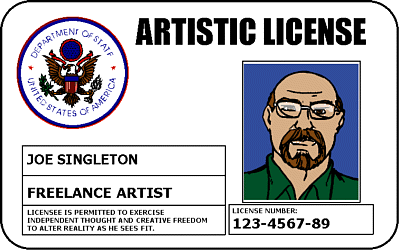|
She began her long career, one of the longest in comics history, in the December/January (Dec. 1941) issue of All-Star Comics in a 9-page origin story. This was followed, almost immediately by her debut in the first issue of Sensation Comics, and by that summer, had her own title. Wonder Woman had begun the longest running comic starring a female super-hero. This would continue until the title was stopped, following the Crisis on Infinite Earths, when her origin was re-written and the title launched again, with a new #1, this time written and penciled by George Perez.
Wonder Woman was the brainchild of William Moulton Marston and the head of what would one day become DC Comics, Max Gaines. Writing under the pen name, Charles Moulton, a combination of Gaines's and Marston's middle names, Marston would continue on the series, until his death, in 1947. From the beginning, his intention was to create a heroic character who not only exemplified the best traits of humanity, but, could also inspire readers to change their attitudes toward women. By creating a powerful woman character who used her power to help people in trouble, he seemed to be saying that men need not fear empowered women.
On the downside, Marston's run on the book often featured women in bondage, which possibly shows that he wasn't as "enlightened" as we'd like to hope. Or, he may have bent to editorial demands, I can't say, really. In an interview in 1942, Marston said that Wonder Woman was the embodiment of boys' (and mens') desire to be dominated by beautiful, strong woman who loved them.
Wonder Woman's original costume remained relatively unchanged, for years. From the waist, up, at least. She began with a loose skirt that fell half-way to her knees, but the hemline crept upward, quickly. Soon the skirt was abandoned for what looked like loose shorts and these were replaced by tight shorts, within a few issues. By Sensation Comics #9, she was wearing virtually the same costume she would wear until the 1960s. For awhile, she traded the high-heeled boots for ballet slippers. Anyone who has read my column before, knows how I stand on footgear. High heels are, at least, useful in a fight! What was she going to do in ballet slippers, dance the villains into submission?

After Marston's death, the focus of the book was gone. Subsequent writers simply did not know what to do with her, so Wonder Woman waffled back and forth from being a pseudo-romance title to preachy, flag-waving.
And then came Wertham. I hope there really is a Hell, and that Dr. Frederic Wertham has a nice toasty corner of it, because he, almost single-handed, destroyed the Golden Age of comics. With his book "Seduction of the Innocents:The influence of comic books on today's youth", Wertham joins the makers of Reefer Madness in my personal Hall of Shame. I mean, give me a break, boys reading Batman are going to "turn" gay, because they see a drawing of a boy and a man going to sleep, in seperate beds, in the same room? Here's a clue, boys never, ever identified with the kid sidekick, we always, identified with the adult hero. No boy ever told his mom he wanted to dress up as Robin on Halloween, we wanted to be Batman! I doubt that a significant number of girls reading Wonder Woman were "converted" to lesbianism, after reading one of Wonder Woman's speeches for women to be strong and independent. To my mind, Wertham was pure evil in the most insidious way, because, I am fairly certain, he felt he could read, view or hear any material, without harmful effect. However, other's must be protected from such "influences"! Freedom of speech and thought, means freedom for everyone, not just those few in the elite who are immune to the evil influences of ideas and images of which they disapprove. I'll put my soap box away, now.
Following the furor created by Wertham's book and subsequent congressional hearings, the entire comics industry was crippled. Wonder Woman no longer spoke out on feminist issues and as a hero, was little more than a watered-down Superman. Whole issues were dedicated to pining away over Steve Trevor and other love interests.
With the advent of the Silver Age. Comics were revitalized, for a time, but Wonder Woman seemed to be stuck in the 50s. By the late 60s, it was time for a change. Wonder Woman gave up her powers, to remain in "man's world" as the Amazons were so fond of calling it and dropped the costume, for a period of two years. During this period, she wore a series of "Mod" outfits, based on real fashions of the time. Yes, she looked like an extra from "Austin Powers", although she completely missed out on the drugs and shagging. During this period, she learned martial arts and followed a blind mentor who called himself "I Ching".
Fortunately, this fashion disaster was relatively short-lived. Comic book scheduling is such that it is nearly impossible to maintain a schedule and remain on the "cutting edge" of fashion. Besides, the "Mod" period was rather short and the fashions that followed were even less suited to Wonder Woman.

A return of her costume accompanied a return of her Amazon powers, but did little to breathe life into her series and it languished in low sales for awhile longer.
It took a television show to really kick Wonder Woman's sales up, with the premier of "The New Original Wonder Woman" on ABC, starring Lynda Carter as Wonder Woman. Set in the 1940s, the series was about as true to the Golden Age Wonder Woman as it could be, considering the budget limitations and television's own weaknesses. This lasted for one season, on ABC and caused DC to change the focus of the Wonder Woman comic, for a time, to the same World War II period. CBS picked up the show, retooled and set in modern times and it continued for two more years. Lynda Carter spinning and transforming into Wonder Woman is one of the most potent, memorable images of the character, ever. Here we are, years later, and there are fin sites dedicated to her and her version of Wonder Woman, as well as a movement to have her cast to play Hippolyta, Wonder Woman's mother, in any movie version that may come along.
The comic returned to a modern setting, as well, but nothing seemed able to bring Wonder Woman out of the rear of the pack. Even the decision to update her look, somewhat, but altering the gold eagle emblem on her chest, didnt help. I think Fred Hembeck, in one of his comic parodies, said it best. Wonder Woman comes up to him, in that vast empty space that he occupied, where all characters from all publishers coexisted, from time, to time. I'm paraphrasing, here, as I could not dig out the actual book this was in...
"What do you think?" she asks, chest thrust out.
"Hmmmm," he ponders,"....Fantastic! All-in-all, a perfect set of Amazon breasts!"
"No! My double-W emblem, you moron!" she shreiks.
"Oh, that's nice, too."
Ho-hum.
A nice peice of design work, but overall, who cares?
I like the way more recent artists have tried rendering the W-Ws to look more and more bird-like. Why should an Amazon princess have an emblem that is made of stylized Roman letters? Anyone?
When Wonder Woman died in the Crisis on Infinite Earths, it was almost a relief. By that time, she had gone so far off-track that it was sometimes painful to read her book.
When Wonder Woman #1 appeared, in 1987, this time written and penciled by George Perez, there were some obvious changes. Small, but obvious. The famous bracelets went from dark, blue-gray to bright, silver/white and lengthened to appear more as vambraces (the forearm covering, in armor terms) than slave bracelets. The slave bracelets were the Amazons'reminder of the consequences of being too trusting of Hercles and his soldiers. Bright and silvery, they're more like jewelry.
Also missing, were the high heels on her boots. Perez said he removed the heels because they are a symbol of dominance. Apparently, he forgot to read Marston's comments on the idea behind Wonder Woman. The early Perez Wonder Woman was quite different from the original, her powers were gifts from the gods, not hard-earned abilities. Where the original was clearly a woman, in her first appearance, Perez's version seemed little more than a girl, maybe 18 years old (or the equivalent). Indeed, she appeared younger than her former (pre-Crisis protegé, Wonder Girl/Donna Troy) She seemed smaller. Hell, she didn't even speak English! To be sure, Perez's version of the Amazons was somewhat different, as well. They were more isolated, than before, and lived very much like the ancient Greeks.
I suppose it's lucky that, at about the same time, Superman was being revamped, because next to the Superman who could fly to distant stars in minutes or travel through time, at will, the revamped Wonder Woman would have looked even smaller.
She's had a pretty rough time of it, too. Her villains became nastier, the war-god Ares, prominent among them. She's had to face challenges to her right to remain Wonder Woman, losing the title to another Amazon, Artemis, for a time. Meanwhile, thanks to artists with mammary issues, her bustline has far exceeded the ability of her costume to adequately cover her. One deep breath, or, should she reach up to the top shelf to get a bad of oreos for the Martion Manhunter, and she's going to be exposed for all of fandom to see. Don't get me wrong, I like to look at breasts just as much as the next guy, but come on! One of the changes Perez made to her costume, which is not readily apparent from looking at it, the whole red-and-gold, upper part of the costume is now a piece of armor. Sure, it covers the soft, unprotected abdomen, but that's all, and there's nothing there to hold it up.
As you progress, as an artist, one of the things you begin to do is develop a sense of "mass", in your drawings. At first, it's acceptable for the figure to seems to float, weightless, in space. Later, you should learn to "ground" the figure and, later still, learn how movement and position effect the distribution of body mass. Skin and muscles stretch and deform, bulge, compress and fold. What does this have to do with this article? Well, in her present costume, if Wonder Woman reached much above her eye level, the stretching of her deltoid and pectoral muscles would pop her right out of the top of that outfit. In a fight, she'd be bare-breasted after throwing the first punch and the top edge of that armor-bodice would be gouging her ample bosoms, something fierce! Now, I can see many cases where the mere presence of a bare-breasted Amazon would stop all fighting, immediately, but you can't do that in a Comics Code approved book.
Of course, all this leads up to me taking a whack at her costume, right?
Wonder Woman is one of DC's "Big Three" and that means you don't want to do anything that is going to make her unrecognizable. Elements I wanted to keep include the overall color scheme and the idea that parts of the costume are armored. One of the first things I sketched out was the tiara. I enlarged it, a bit and incorporated a bit of the "W" and the stylized eagle, in it's form. When it came to the breast plate, I kept it nearly standard, altering the emblem a bit dramatically and flaring the lower edge, a bit.
She may still be wearing her star-spangled panties, but not on the outside. Beneath the armor-bodice, she wears a short tunic of navy blue that gathers at the left shoulder. Over the tunic, she wears a protective skirt of dark blue leather strips, in the ancient style. Silver stars on the ends of the strips provide some protection and also give her a simple ring of stars, in place of the star-spangled panties.
I always liked Wonder Woman's boots, but I agree with Perez's removing the stiletto heels, but for more practical reasons. While the heels were preferable to the flimsy ballet-slipper style footgear that she sometimes wore, they are hard to fight, or run, in. However, I thought she should have a little more protection, so I brought the tops up over the knee. I also thought a little more blue, here, would look good.
Just as more recent artists have taken the bracelets further and further from the original slave bracelets, I've abandoned them altogether. I'm not going for symbolism, as Moulton intended. My thought is for what looks good, would probably be reasonably functional and suits the style of the costume.

Maybe this draws too much from Xena: Warrior Princess, but it looks more like a fighter's outfit, to me. Wonder Woman has evolved, from the original concept and so should her costume. A sword wouldn't look out of place, slung from her waist, either.
|




